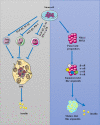Stem Cell Transplantation in the Treatment of Type 1 Diabetes Mellitus: From Insulin Replacement to Beta-Cell Replacement
- PMID: 35370989
- PMCID: PMC8972968
- DOI: 10.3389/fendo.2022.859638
Stem Cell Transplantation in the Treatment of Type 1 Diabetes Mellitus: From Insulin Replacement to Beta-Cell Replacement
Abstract
Type 1 diabetes mellitus (T1DM) is an autoimmune disease that attacks pancreatic β-cells, leading to the destruction of insulitis-related islet β-cells. Islet β-cell transplantation has been proven as a curative measure in T1DM. However, a logarithmic increase in the global population with diabetes, limited donor supply, and the need for lifelong immunosuppression restrict the widespread use of β-cell transplantation. Numerous therapeutic approaches have been taken to search for substitutes of β-cells, among which stem cell transplantation is one of the most promising alternatives. Stem cells have demonstrated the potential efficacy to treat T1DM by reconstitution of immunotolerance and preservation of islet β-cell function in recent research. cGMP-grade stem cell products have been used in human clinical trials, showing that stem cell transplantation has beneficial effects on T1DM, with no obvious adverse reactions. To better achieve remission of T1DM by stem cell transplantation, in this work, we explain the progression of stem cell transplantation such as mesenchymal stem cells (MSCs), human embryonic stem cells (hESCs), and bone marrow hematopoietic stem cells (BM-HSCs) to restore the immunotolerance and preserve the islet β-cell function of T1DM in recent years. This review article provides evidence of the clinical applications of stem cell therapy in the treatment of T1DM.
Keywords: immunotolerance; stem cell; transplantation; type 1 diabetes mellitus; β-cell.
Copyright © 2022 Wan, Zhang, Khan, Zheng, Hu, Zhang, Yang and Xiong.
Conflict of interest statement
The authors declare that the research was conducted in the absence of any commercial or financial relationships that could be construed as a potential conflict of interest.
Figures
Similar articles
-
Human Induced Pluripotent Stem Cells in the Curative Treatment of Diabetes and Potential Impediments Ahead.Adv Exp Med Biol. 2019;1144:25-35. doi: 10.1007/5584_2018_305. Adv Exp Med Biol. 2019. PMID: 30569414 Review.
-
Original hypothesis: Extracorporeal shockwaves as a homeostatic autoimmune restorative treatment (HART) for Type 1 diabetes mellitus.Med Hypotheses. 2014 Sep;83(3):250-3. doi: 10.1016/j.mehy.2014.05.008. Epub 2014 Jun 3. Med Hypotheses. 2014. PMID: 24947195
-
Novel therapy for type 1 diabetes: autologous hematopoietic stem cell transplantation.J Diabetes. 2012 Dec;4(4):332-7. doi: 10.1111/1753-0407.12002. J Diabetes. 2012. PMID: 23190701 Review.
-
In Vivo Bioluminescence for the Detection of the Fate of Pancreatic Islet Organoids Post-transplantation.Methods Mol Biol. 2023;2592:195-206. doi: 10.1007/978-1-0716-2807-2_14. Methods Mol Biol. 2023. PMID: 36507995
-
Effect of hTIMP-1 overexpression in human umbilical cord mesenchymal stem cells on the repair of pancreatic islets in type-1 diabetic mice.Cell Biol Int. 2021 May;45(5):1038-1049. doi: 10.1002/cbin.11548. Epub 2021 Feb 4. Cell Biol Int. 2021. PMID: 33404139
Cited by
-
Cell Therapies and Gene Therapy for Diabetes: Current Progress.Curr Diabetes Rev. 2025;21(8):e130524229899. doi: 10.2174/0115733998292392240425122326. Curr Diabetes Rev. 2025. PMID: 38747221 Review.
-
Global research trends of diabetes remission: a bibliometric study.Front Endocrinol (Lausanne). 2023 Nov 28;14:1272651. doi: 10.3389/fendo.2023.1272651. eCollection 2023. Front Endocrinol (Lausanne). 2023. PMID: 38089622 Free PMC article.
-
A comparative study of the therapeutic effect of bone marrow mesenchymal stem cells versus insulin on mandibular dento-alveolar complex collagen formation and beta-catenin expression in experimentally induced type I diabetes.Saudi Dent J. 2023 Sep;35(6):668-677. doi: 10.1016/j.sdentj.2023.05.020. Epub 2023 May 30. Saudi Dent J. 2023. PMID: 37817792 Free PMC article.
-
Exploring a novel mechanism for targeting β-arrestin-2 in the management of diabetic nephropathy.World J Diabetes. 2025 Apr 15;16(4):101994. doi: 10.4239/wjd.v16.i4.101994. World J Diabetes. 2025. PMID: 40236866 Free PMC article.
-
Exploring the causal effect of omega-3 polyunsaturated fatty acid levels on the risk of type 1 diabetes: a Mendelian randomization study.Front Genet. 2024 Jul 8;15:1353081. doi: 10.3389/fgene.2024.1353081. eCollection 2024. Front Genet. 2024. PMID: 39040994 Free PMC article.
References
-
- Miller KM, Hermann J, Foster N, Hofer SE, Rickels MR, Danne T, et al. . Longitudinal Changes in Continuous Glucose Monitoring Use Among Individuals With Type 1 Diabetes: International Comparison in the German and Austrian DPV and U.S. T1D Exchange Registries. Diabetes Care (2020) 43(1):e1–2. doi: 10.2337/dc19-1214 - DOI - PMC - PubMed
-
- Wang J, Lv B, Chen X, Pan Y, Chen K, Zhang Y, et al. . An Early Model to Predict the Risk of Gestational Diabetes Mellitus in the Absence of Blood Examination Indexes: Application in Primary Health Care Centres. BMC Pregnancy Childbirth (2021) 21(1):814. doi: 10.1186/s12884-021-04295-2 - DOI - PMC - PubMed
Publication types
MeSH terms
Substances
LinkOut - more resources
Full Text Sources
Other Literature Sources
Medical


